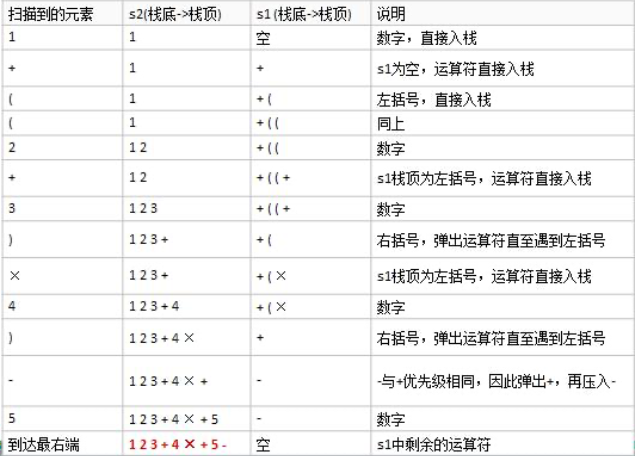中缀表达式转换为后缀表达式(Java)
博客说明
文章所涉及的资料来自互联网整理和个人总结,意在于个人学习和经验汇总,如有什么地方侵权,请联系本人删除,谢谢!
步骤
初始化两个栈:运算符栈 s1 和储存中间结果的栈 s2
从左至右扫描中缀表达式
遇到操作数时,将其压 s2
遇到运算符时,比较其与 s1 栈顶运算符的优先级:
- 如果 s1 为空,或栈顶运算符为左括号“(”,则直接将此运算符入栈
- 否则,若优先级比栈顶运算符的高,也将运算符压入 s1;
- 否则,将 s1 栈顶的运算符弹出并压入到 s2 中,再次转到(4-1)与 s1 中新的栈顶运算符相比较;
遇到括号时:
- 如果是左括号“(”,则直接压入 s1
- 如果是右括号“)”,则依次弹出 s1 栈顶的运算符,并压入 s2,直到遇到左括号为止,此时将这一对括号丢弃
重复步骤 2 至 5,直到表达式的最右边
将 s1 中剩余的运算符依次弹出并压入 s2
依次弹出 s2 中的元素并输出,结果的逆序即为中缀表达式对应的后缀表达式
案例
将中缀表达式“1+((2+3)×4)-5”转换为后缀表达式的过程如下
因此结果为 :”123+4 × +5 –”

代码
1
2
3
4
5
6
7
8
9
10
11
12
13
14
15
16
17
18
19
20
21
22
23
24
25
26
27
28
29
30
31
32
33
34
35
36
37
38
39
40
41
42
43
44
45
46
47
48
49
50
51
52
53
54
55
56
57
58
59
60
61
62
63
64
65
66
67
68
69
70
71
72
73
74
75
76
77
78
79
80
81
82
83
84
85
86
87
88
89
90
91
92
93
94
95
96
97
98
99
100
101
102
103
104
105
106
107
108
109
110
111
112
113
114
115
116
117
118
119
120
121
122
123
124
125
126
127
128
129
130
131
132
133
134
135
136
137
138
139
140
| package stack;
import java.util.ArrayList;
import java.util.List;
import java.util.Stack;
public class PolandNotation {
public static void main(String[] args) {
String suffixExpression = "1+((2+3)*4)-5";
System.out.println("中缀表达式对应的List");
List<String> infixExpressionList = toInfixExpressionList(suffixExpression);
System.out.println(infixExpressionList);
System.out.println("后缀表达式对应的List");
List<String> suffixExpressionList = parseSuffixExpressionList(infixExpressionList);
System.out.println(suffixExpressionList);
System.out.printf("suffixExpression=%d", calculate(suffixExpressionList));
}
public static List<String> parseSuffixExpressionList(List<String> ls) {
Stack<String> s1 = new Stack<String>();
List<String> s2 = new ArrayList<String>();
for (String item : ls) {
if (item.matches("\\d+")) {
s2.add(item);
} else if (item.equals("(")) {
s1.push(item);
} else if (item.equals(")")) {
while (!s1.peek().equals("(")) {
s2.add(s1.pop());
}
s1.pop();
} else {
while (s1.size() != 0 && Operation.getValue(s1.peek()) >= Operation.getValue(item)) {
s2.add(s1.pop());
}
s1.push(item);
}
}
while (s1.size() != 0) {
s2.add(s1.pop());
}
return s2;
}
public static List<String> toInfixExpressionList(String s) {
List<String> ls = new ArrayList<String>();
int i = 0;
String str;
char c;
do {
if ((c = s.charAt(i)) < 48 || (c = s.charAt(i)) > 57) {
ls.add("" + c);
i++;
} else {
str = "";
while (i < s.length() && (c = s.charAt(i)) >= 48 && (c = s.charAt(i)) <= 57) {
str += c;
i++;
}
ls.add(str);
}
} while (i < s.length());
return ls;
}
public static int calculate(List<String> ls) {
Stack<String> stack = new Stack<>();
for (String item : ls) {
if (item.matches("\\d+")) {
stack.push(item);
} else {
int num2 = Integer.parseInt(stack.pop());
int num1 = Integer.parseInt(stack.pop());
int res = 0;
if (item.equals("+")) {
res = num1 + num2;
} else if (item.equals("-")) {
res = num1 - num2;
} else if (item.equals("*")) {
res = num1 * num2;
} else if (item.equals("/")) {
res = num1 / num2;
} else {
throw new RuntimeException("运算符有问题");
}
stack.push("" + res);
}
}
return Integer.parseInt(stack.pop());
}
}
class Operation {
private static int ADD = 1;
private static int SUB = 1;
private static int MUL = 2;
private static int DIV = 2;
public static int getValue(String operation) {
int result = 0;
switch (operation) {
case "+":
result = ADD;
break;
case "-":
result = SUB;
break;
case "*":
result = MUL;
break;
case "/":
result = DIV;
break;
default:
System.out.println("不存在");
break;
}
return result;
}
}
|
感谢
尚硅谷
万能的网络
以及勤劳的自己




